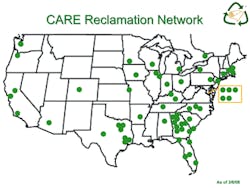Carpet Reclamation: Closing the Loop
When choosing new carpet for your buildings, consider the green aspects of each product. How much recycled content is included? Are the fibers and dyes harmful for the environment or building occupants?
These are important questions, but you may be missing a major point that's literally right in front of (and under) you: What's going to happen to your existing carpet? Carpet reclamation should be your first choice. Consider the following factors when you decide what to do with old carpet, and learn how to pursue easy and inexpensive carpet reclamation.
Why reclaim carpet?
There's no question that reclaiming used carpet is good for the environment. Consider these facts when purchasing or throwing away carpet:
- Carpet takes more than 50 years to begin to decompose in a landfill.
- One (1) square yard of carpet weighs as much as the amount of trash the average American throws away each day.
- Carpet accounts for 2 to 3 percent of all landfill volume.
- For every ton of carpet recycled, 2 tons of CO2 are prevented from entering the atmosphere.
"Reclaiming carpet can help reduce your facility's environmental footprint," says Kim Matsoukas, LEED AP and sustainability manager at City of Industry, CA-based Bentley Prince Street. "In order to break our dependency on petroleum-based raw materials, we need a steady supply of post-consumer recycled carpet to add recycled content to carpet products," she adds.
The environment will benefit from reclaiming your old carpet, but you will also see economic benefits. Depending on what region you're in, it can actually be less expensive to recycle carpet than to send it to a landfill. And, depending on the type of carpet being recycled, reclamation can even be free.
Reclamation is now easier
In the past, carpet reclamation could be difficult, time consuming, and expensive. This is no longer the case, as the carpet industry has taken proactive steps to help building owners keep carpet out of landfills by turning old carpet into new carpet, reusing the old carpet in another setting, refurbishing old carpet, or recycling carpet fiber into other plastic products.
The Carpet America Recovery Effort (CARE)—an industry and government effort to reduce the amount of carpet waste going to landfills and increase the recycled content of carpet products—helps carpet companies, government entities, and product suppliers develop new solutions for post-consumer carpet. A map of carpet-reclamation centers in the United States can be found at www.carpetrecovery.org/waste.php, along with downloadable lists of reclamation opportunities.
The basic rule of reclaiming your old carpet: The dealer or contractor handling your project's demolition is the one responsible for its disposal. "Dealers are often more than willing to absorb part of the cost of reclamation, if there is one," says Matsoukas. Reclamation costs are determined by the carpet material, the amount of carpet, and the logistics concerning location.
Each reclamation program has different specifications for carpet-disposal preparation, so do your homework once you've found a reclamation center to make sure you operate within its guidelines. Generally, carpet tile should be palletized and shrink wrapped, broadloom should be rolled or cut into strips, and carpet must be dry, clean, and separated from other materials. Check out the sidebar for quick tips on how you can help close the loop with your building's carpet.
Jenna M. Aker ([email protected]) is new products editor at Buildings magazine.

